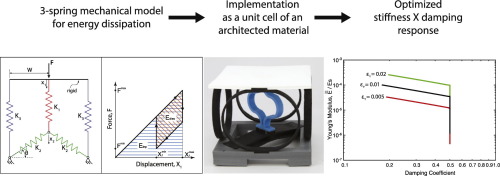当前位置:
X-MOL 学术
›
Mater. Des.
›
论文详情
Our official English website, www.x-mol.net, welcomes your
feedback! (Note: you will need to create a separate account there.)
Optimal design of a cellular material encompassing negative stiffness elements for unique combinations of stiffness and elastic hysteresis
Materials & Design ( IF 7.6 ) Pub Date : 2017-12-01 , DOI: 10.1016/j.matdes.2017.09.001 Anna Guell Izard , Ricardo Fabian Alfonso , Geoffrey McKnight , Lorenzo Valdevit
Materials & Design ( IF 7.6 ) Pub Date : 2017-12-01 , DOI: 10.1016/j.matdes.2017.09.001 Anna Guell Izard , Ricardo Fabian Alfonso , Geoffrey McKnight , Lorenzo Valdevit

|
Abstract Viscoelastic materials are commonly used to dissipate kinetic energy in case of impact and vibrations. Unfortunately, dissipating large amounts of energy in a monolithic material requires high combinations of two intrinsic properties – Young's modulus and loss factor, which are generally in conflict. This limitation can be overcome by designing cellular materials incorporating negative stiffness elements. Here we investigate a configuration comprising two positive stiffness elements and one negative stiffness element. This unit cell possesses an internal degree of freedom, which introduces hysteresis under a loading-unloading cycle, resulting in substantial energy dissipation, while maintaining stiffness. We demonstrate and optimize a simple implementation in a single material design that does not require external stabilization or pre-compression of buckled elements; these key features make it amenable to fabrication by virtually any additive manufacturing approach (from 3D printing to assembly and brazing) in a wide range of base materials (from polymers to metals). No additional intrinsic damping mechanism is required for the base material, which is assumed linear elastic. Furthermore, the architected material can be designed to be fully recoverable. When optimized, these architected materials exhibit extremely high combinations of Young's modulus and damping, far superior to those of each constituent phase.
中文翻译:

包含负刚度元件的蜂窝材料的优化设计,以实现刚度和弹性滞后的独特组合
摘要 粘弹性材料通常用于在冲击和振动情况下耗散动能。不幸的是,在单片材料中耗散大量能量需要两种固有特性的高度组合——杨氏模量和损耗因子,它们通常是相互矛盾的。这种限制可以通过设计包含负刚度元素的蜂窝材料来克服。在这里,我们研究了一种包含两个正刚度元件和一个负刚度元件的配置。该单元具有内部自由度,在加载-卸载循环下引入滞后,导致大量能量耗散,同时保持刚度。我们在单一材料设计中演示和优化了一个简单的实现,不需要外部稳定或预压缩弯曲元件;这些关键特性使其几乎可以通过任何增材制造方法(从 3D 打印到组装和钎焊)在各种基础材料(从聚合物到金属)中进行制造。基础材料不需要额外的固有阻尼机制,假设为线弹性。此外,建筑材料可以设计为完全可回收。优化后,这些结构材料表现出极高的杨氏模量和阻尼组合,远远优于每个组成相的组合。这些关键特性使其几乎可以通过任何增材制造方法(从 3D 打印到组装和钎焊)在各种基础材料(从聚合物到金属)中进行制造。基础材料不需要额外的固有阻尼机制,假设为线弹性。此外,建筑材料可以设计为完全可回收。优化后,这些结构材料表现出极高的杨氏模量和阻尼组合,远远优于每个组成相的组合。这些关键特性使其几乎可以通过任何增材制造方法(从 3D 打印到组装和钎焊)在各种基础材料(从聚合物到金属)中进行制造。基础材料不需要额外的固有阻尼机制,假设为线弹性。此外,建筑材料可以设计为完全可回收。优化后,这些结构材料表现出极高的杨氏模量和阻尼组合,远远优于每个组成相的组合。
更新日期:2017-12-01
中文翻译:

包含负刚度元件的蜂窝材料的优化设计,以实现刚度和弹性滞后的独特组合
摘要 粘弹性材料通常用于在冲击和振动情况下耗散动能。不幸的是,在单片材料中耗散大量能量需要两种固有特性的高度组合——杨氏模量和损耗因子,它们通常是相互矛盾的。这种限制可以通过设计包含负刚度元素的蜂窝材料来克服。在这里,我们研究了一种包含两个正刚度元件和一个负刚度元件的配置。该单元具有内部自由度,在加载-卸载循环下引入滞后,导致大量能量耗散,同时保持刚度。我们在单一材料设计中演示和优化了一个简单的实现,不需要外部稳定或预压缩弯曲元件;这些关键特性使其几乎可以通过任何增材制造方法(从 3D 打印到组装和钎焊)在各种基础材料(从聚合物到金属)中进行制造。基础材料不需要额外的固有阻尼机制,假设为线弹性。此外,建筑材料可以设计为完全可回收。优化后,这些结构材料表现出极高的杨氏模量和阻尼组合,远远优于每个组成相的组合。这些关键特性使其几乎可以通过任何增材制造方法(从 3D 打印到组装和钎焊)在各种基础材料(从聚合物到金属)中进行制造。基础材料不需要额外的固有阻尼机制,假设为线弹性。此外,建筑材料可以设计为完全可回收。优化后,这些结构材料表现出极高的杨氏模量和阻尼组合,远远优于每个组成相的组合。这些关键特性使其几乎可以通过任何增材制造方法(从 3D 打印到组装和钎焊)在各种基础材料(从聚合物到金属)中进行制造。基础材料不需要额外的固有阻尼机制,假设为线弹性。此外,建筑材料可以设计为完全可回收。优化后,这些结构材料表现出极高的杨氏模量和阻尼组合,远远优于每个组成相的组合。










































 京公网安备 11010802027423号
京公网安备 11010802027423号